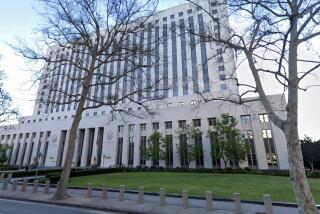An Old City Scandal May Resurface : Heritage: An Olvera Street mural, whitewashed over in 1932 when it shocked local residents, may be resurrected by a new generation of Latinos.
When they unveiled the epic painting covering an entire building wall on Olvera Street in 1932, the crowd gasped.
Scandalized by the explosive images of the 80-by-16-foot mural painting, shopkeepers and community leaders stared in disbelief at the portrayal of a Mexican Indian in loincloth hanging from a cross with a predatory American eagle overhead.
City leaders immediately ordered the mural whitewashed.
Now, more than 50 years later, a new generation of Olvera Street merchants has joined forces with art historians and preservationists to save the nearly forgotten work by master Mexican muralist David Alfaro Siqueiros.
The late artist was one of “Los Tres Grandes”--Mexico’s renowned triumvirate of artists who included Diego Rivera and Jose Clemente Orozco, who brought worldwide fame to the huge, politically charged murals of Mexico.
Siqueiros’ desecrated mural has become an important symbol to Olvera Street’s Latino merchants and its preservation a matter of community pride.
“The mural is important to us as Latinos,” said Vivien Bonzo, president of the Olvera Street Merchants’ Assn. “It helps give us some perspective on where we have come from. And it speaks to the growth and development of our community.”
The merchants have joined a longstanding but--until recently--faltering effort to bring the mural back to public view. And renewed interest from art foundations has raised hopes that Siqueiros’ nearly forgotten gift to Los Angeles will finally be reclaimed.
“We’re going to get it done this time,” said Bonzo, echoing the optimism of others involved in the effort.
The merchants are working to draw broad-based community support from Latino and labor organizations, clout that earlier restoration efforts lacked, Bonzo said. The merchants plan to kick off their campaign this evening with a fund-raising dinner at Olvera Street.
Meanwhile, El Pueblo de Los Angeles State Historic Park, which owns the Olvera Street buildings, has received state funding for seismic reinforcement of the two-story Italian Hall where Siqueiros painted his mural.
The park’s curator, Jean Bruce Poole, who has spearheaded the decade-long campaign to restore the mural, has won support from Friends of Mexico, an organization dedicated to improving the image of Mexican art and culture abroad.
Supervising work on the mural, the nonprofit organization is about to contract with a conservation expert from Mexico to direct the delicate work of preserving the mural. And the Getty Conservation Institute has agreed to provide conservation workers to assist in the project, she said.
Noting the symbolism in reclaiming Siqueiros’ whitewashed mural, Miriam Bertram, Friends of Mexico project director, added that “there’s a greater sense of pride in the Hispanic community of Southern California and this is a symbol of that pride.”
Siqueiros came to Los Angeles in 1932 in exile, escaping persecution in Mexico for his Communist Party activities.
The artist arrived in the midst of the country’s worst depression. Like novelist John Steinbeck, he was outraged by the exploitation of migrant workers. Siqueiros, who himself was deported from the United States when his visa expired, also witnessed the mass deportation by immigration authorities of tens of thousands of Mexican workers and their families.
When Siqueiros got the opportunity to create a public mural in the heart of Los Angeles’ Mexican birthplace, he painted “America Tropical,” a monumental protest against the inhumanity he saw. The political statement was a far cry from the pleasing portrayal that city leaders expected.
The campaign to save the Olvera Street mural is well on its way now toward raising the $125,000 needed for the preservation work, Bertram said. Additional funds will be needed to construct a protective covering for the mural and a viewing platform.
If the campaign goes as well as expected, Poole said, the mural might be on display as early as next year.
The years of neglect have exacted a heavy toll, however. The mural long ago lost its protective layers of whitewash and its once brilliant colors have faded to a mere shadow of their original vibrancy. Today, the mural is covered by a wood framework, which Poole had installed several years ago to protect it from further deterioration.
Unfortunately, Poole said, it is too late to fully revive the mural. “But it is certainly worth conserving what we have left,” she said.
The goal of the project will be to “conserve,” rather than restore, what is left of Siqueiros’ mural. It will be cleaned and carefully touched up, but not repainted, said Poole.
“You can’t repaint it. You would be violating the work of a major master . . . and the integrity of the mural,” she explained.
Still, she added, the conservation is “a final recognition for a great work of art, a great artist, and a part of our history.”
More to Read
Sign up for Essential California
The most important California stories and recommendations in your inbox every morning.
You may occasionally receive promotional content from the Los Angeles Times.






